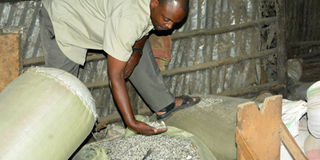Prime
Use concentrates as an alternative to feeding

Marine shells add nutrients to maize bran. Poultry farmers are encouraged to make concentrates for a better return. File photo
What you need to know:
High costs of production is the main reason many poultry farmers are being pushed out of the business. Yet poultry remains an important element in agriculture. Experts argue that feeds and drugs is one element that pushes the costs high, writes George Katongole.
Kennedy Musau is a small-time poultry keeper in Kansanga. Minimising costs is the secret he has been in business for more than seven years. He suggests many ways to cut cut costs. In his case, he uses solar lights in his coop on top of growing kales (sukuma wiki).
“Keeping chicken warm in the brooder is vital yet power costs are high. That is why I have a solar power system. When the chicken are ready, I feed them on greens I grow in my garden. Keeping costs down is essential for sustainability,” Musau, also a teacher at Rainbow International School, says.
Production costs
Livestock feed accounts for between 60 and 70 per cent of total production costs. The high costs of silverfish used in feeds threatens the use of fishmeal in poultry.
Silverfish and soy meal, both now scarce commodities, are a major source of proteins for poultry. Researchers say silverfish was preferred because it includes digestible crude protein, and essential amino acids along with fat, vitamins and minerals.
But limited availability in recent years has limited fishmeal inclusion in poultry diets paving way for concentrates.
Kaoudijs are among the leading suppliers of feed concentrates in Uganda. According to Atanansi Ssekadde, an agronomist with Kaoudijs, “attaining incredible returns from a poultry project is achievable within a farmer’s means,” Ssekadde says.
Kaoudijs supplies a wide range of feeds especially poultry. Separate formulas are available for layers and broilers.
Concentrates are developed in laboratories and assures availability of all essential nutrients for optimal production.
Ssekadde says that layers, for instance, produce more eggs when they are well fed. “Not only the egg production, but also the taste of the egg is influenced by the feed,” he says.
Currently, 100 kilogrammes of prepared pellet feed costs more than Shs240,000 yet when farmers choose to use premixes of concentrates, the cost goes down by more than 100 per cent.
Components
According to Rashid Katongole, a veterinary supplier in Mukono Industrial Area, using concentrates requires the addition of broken maize, maize bran, marine shells.
His recommendation is for layers mixing 25 per cent of concentrates in 30 kilogrammes of broken maize, 40 kilogrammes of maize bran with the rest being marine shells. This mixture can cost about Shs135,000 for 100 kilogrammes.
“The reduction in cost is noticeable. I would recommend people using concentrates,” Katongole, the proprietor of Avemar Poultry Supply, says.
Joyce Nalikka Nsubuga of Rena Agro Centre, the feed partners of Dutch-based manufacturers Champrix says farmers ought to embrace concentrates for optimal results.
The feeds can be mixed with concentrates of 20, 5 or 35 per cent. “If farmers fail to manage feed costs, they may end up quitting the business. But with concentrates, farm costs can easily be managed,” Nalikka says.
Champrix offers further support to farmers through the ChampOptimiser tool on phones and computers. This helps farmers mix the right ingredients as may be required.
Why concentrates are your best companion
According to researchers, concentrate feed is used with another to improve the nutritive balance and produces a supplement or a complete feed.
Concentrate feed normally contains higher percentages of energy, protein, vitamins, minerals, amino acids, enzymes and organic acids.
Therefore, concentrate feeds should be first mixed with other ingredients before it is served to animals.
Concentrate feeds are available for different animals such as poultry, pigs and ruminants.
Although concentrate has different names, they serve a similar purpose. It is advantageous because it is cheaper, saves time and reduced labour costs. But there are possibilities of making mistakes when mixing and yet they cannot be used alone.
Other options
According to Insect Feed for poultry and fish production in Sub-Saharan Africa (INSFEED), researchers identified more than 10 insect species suitable for use in poultry feed.
The alternative insects include grasshoppers, housefly maggots, Westwood larvae, termites, and garden snail, among others.
But producing the necessary volumes has been a great limitation even though farmers would be willing to use them.




